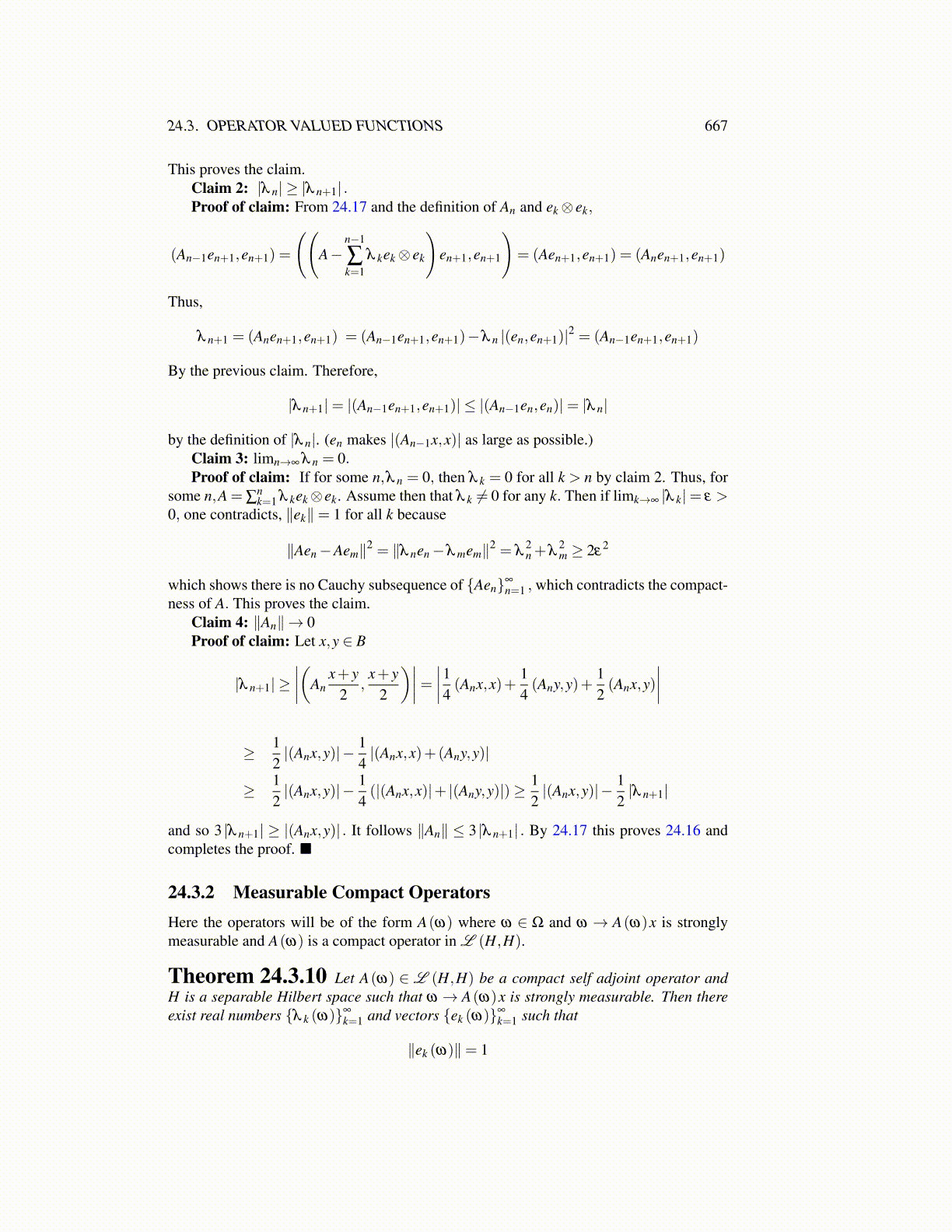
24.3. OPERATOR VALUED FUNCTIONS 667
This proves the claim.Claim 2: |λ n| ≥ |λ n+1| .Proof of claim: From 24.17 and the definition of An and ek⊗ ek,
(An−1en+1,en+1) =
((A−
n−1
∑k=1
λ kek⊗ ek
)en+1,en+1
)= (Aen+1,en+1) = (Anen+1,en+1)
Thus,
λ n+1 = (Anen+1,en+1) = (An−1en+1,en+1)−λ n |(en,en+1)|2 = (An−1en+1,en+1)
By the previous claim. Therefore,
|λ n+1|= |(An−1en+1,en+1)| ≤ |(An−1en,en)|= |λ n|
by the definition of |λ n|. (en makes |(An−1x,x)| as large as possible.)Claim 3: limn→∞ λ n = 0.Proof of claim: If for some n,λ n = 0, then λ k = 0 for all k > n by claim 2. Thus, for
some n,A = ∑nk=1 λ kek⊗ek. Assume then that λ k ̸= 0 for any k. Then if limk→∞ |λ k|= ε >
0, one contradicts, ∥ek∥= 1 for all k because
∥Aen−Aem∥2 = ∥λ nen−λ mem∥2 = λ2n +λ
2m ≥ 2ε
2
which shows there is no Cauchy subsequence of {Aen}∞
n=1 , which contradicts the compact-ness of A. This proves the claim.
Claim 4: ∥An∥→ 0Proof of claim: Let x,y ∈ B
|λ n+1| ≥∣∣∣∣(An
x+ y2
,x+ y
2
)∣∣∣∣= ∣∣∣∣14 (Anx,x)+14(Any,y)+
12(Anx,y)
∣∣∣∣≥ 1
2|(Anx,y)|− 1
4|(Anx,x)+(Any,y)|
≥ 12|(Anx,y)|− 1
4(|(Anx,x)|+ |(Any,y)|)≥ 1
2|(Anx,y)|− 1
2|λ n+1|
and so 3 |λ n+1| ≥ |(Anx,y)| . It follows ∥An∥ ≤ 3 |λ n+1| . By 24.17 this proves 24.16 andcompletes the proof. ■
24.3.2 Measurable Compact OperatorsHere the operators will be of the form A(ω) where ω ∈ Ω and ω → A(ω)x is stronglymeasurable and A(ω) is a compact operator in L (H,H).
Theorem 24.3.10 Let A(ω) ∈ L (H,H) be a compact self adjoint operator andH is a separable Hilbert space such that ω → A(ω)x is strongly measurable. Then thereexist real numbers {λ k (ω)}∞
k=1 and vectors {ek (ω)}∞
k=1 such that
∥ek (ω)∥= 1